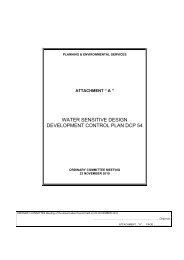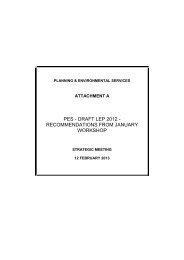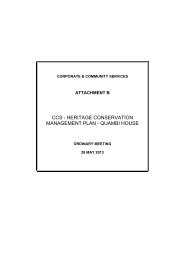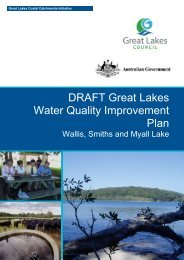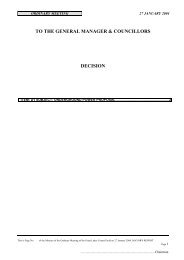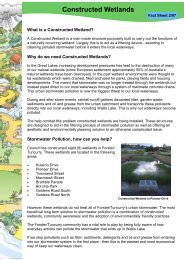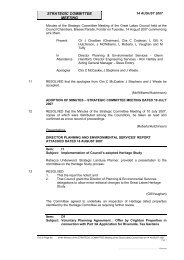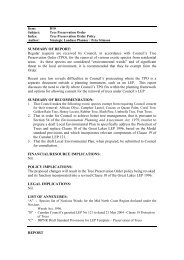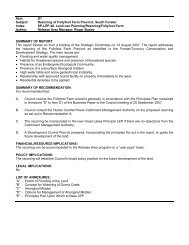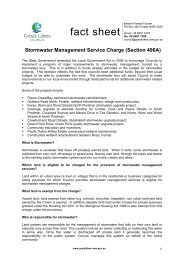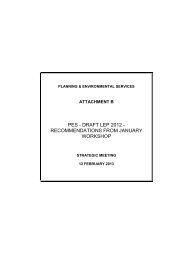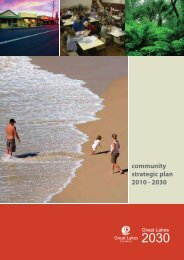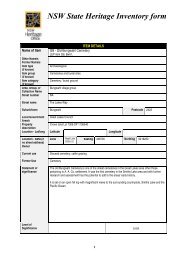13.2 The Wallis Lake Estuary Management Committee - Great Lakes ...
13.2 The Wallis Lake Estuary Management Committee - Great Lakes ...
13.2 The Wallis Lake Estuary Management Committee - Great Lakes ...
You also want an ePaper? Increase the reach of your titles
YUMPU automatically turns print PDFs into web optimized ePapers that Google loves.
<strong>Wallis</strong> <strong>Lake</strong> <strong>Estuary</strong> <strong>Management</strong> Plan<br />
Recommendations from the conservation strategy were employed in the CDS, however this will soon be replaced<br />
by the biodiversity strategy that is currently being prepared. When this occurs it is recommended that the<br />
conservation zones of the CDS be reviewed.<br />
13.1.10 Forster/Tuncurry Floodplain <strong>Management</strong> Plan<br />
<strong>The</strong> Forster/Tuncurry Floodplain <strong>Management</strong> Plan, finalised in 1998, provides the ‘basis for future management of<br />
flood liable lands and the management of development within the Forster and Tuncurry floodplain areas’. Structural<br />
(ie. levees and dredging) as well as non-structural (effective flood warning and evacuation systems) options were<br />
investigated and evaluated for their effectiveness in reducing flood damages. Non-structural options were deemed<br />
to be most cost-effective, and the following key measures were recommended:<br />
• flood forecasting system<br />
• preparation of a detailed evacuation plan<br />
• flood awareness and public education<br />
• voluntary house raising, and<br />
• planning and development controls.<br />
13.1.11 Wallamba River Floodplain risk management plan for Nabiac, Failford and<br />
Minimbah areas<br />
<strong>The</strong> Wallamba River floodplain risk management plan concentrates on extent of flooding from the Wallamba River<br />
only and the risk to surrounding buildings where data is available. <strong>The</strong> document proposes methods of dealing with<br />
existing, future and continuing flood risk. In summary, six prioritised actions were proposed:<br />
• updating development controls to manage future flood risk<br />
• flood planning, education, awareness and data collection to manage continuing flood risk<br />
• timely review this floodplain risk management plan following completion of investigations into the<br />
tributaries or at a maximum of 5 year intervals<br />
• upgrading of access issues in key areas as identified in emergency management planning including<br />
Willow Point Road at Failford and Glen Ora Road at Minimbah<br />
• voluntary house raising to manage existing flood risk, and<br />
• voluntary purchase to manage existing flood risk where dwellings cannot be raised.<br />
13.1.12 <strong>Wallis</strong> <strong>Lake</strong> wetland management strategy<br />
GLC aims to begin preparing a wetland management strategy in 2005 to addresses the recommendations made in<br />
the wetlands action plan of the WLCMP. <strong>The</strong> anticipated goals of this plan will be to identify the wetland areas in<br />
<strong>Wallis</strong> <strong>Lake</strong>, apply for RAMSAR listing of the wetlands under the international convention, and then implement best<br />
practice management guidelines and management criteria under the RAMSAR convention to conserve and<br />
enhance existing wetlands.<br />
13.1.13 Identification of urban and rural inputs to sediments in <strong>Wallis</strong> <strong>Lake</strong> – Chief<br />
Investigators: Logan G. A., MacPhail M., Fredericks D., Smith C. and Heggie D. (2001)<br />
124




